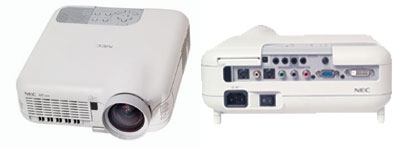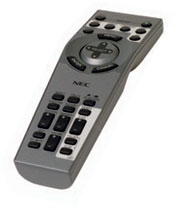Bringing the Theater Home Page 3
NEC HT1000 While Sharp is well known in the consumer world, NEC is more of a behind-the-scenes player with a strong foothold in the industrial market. That's not to say it can't bridge both worlds. The HT1000 is NEC's first serious foray into home theater, and to judge from its wide array of videophile features, the company did its homework. The projector's formless white case and generally drab design recall its industrial lineage, but with a reasonable $4,995 price tag, who's complaining?

| NEC HT1000 |
| DIMENSIONS 10 1/4 inches wide, 4 3/4 inches high, 12 1/2 inches deep WEIGHT 7 pounds PRICE $4,995 MANUFACTURER NEC Solutions America, Dept. S&V, 1250 Arlington Heights Rd., Itasca, IL 60143; www.necvisualsystems.com; 800-632-4636 |
The HT1000 uses a 4:3 aspect ratio DMD with a resolution of 1,024 x 768 pixels - but that gets whittled down to 1,024 x 576 when you use a 16:9 screen. As with Sharp's projector, you need to set the HT1000 for 16:9 and then adjust its zoom lens to fill the screen with a widescreen image. Another similarity to the Sharp is the light spray generated by unused pixels on the NEC's 4:3 DMD.
NEC's owner's manual specifies a zoom range for a 4:3 screen only, but I found I could place the projector about 12 to 14 feet from my widescreen setup. The HT1000 has adjustable feet for varying its angle, and there are horizontal and vertical keystone adjustments plus a feature called 3D Reform that gives you more options for tweaking geometry. The NEC's many adjustments make it easy to get a perfect picture even at off-center positions.
You can't ask for a more complete set of video inputs. Along with standard fare, you get wideband component-video, 15-pin VGA-type RGB, and DVI with HDCP copy protection. This makes it easy to hook up the NEC to a computer, an HDTV tuner, a DVD player, a PlayStation - whatever.
 The wedge-shaped remote fits comfortably in the hand. The keypad isn't backlit, but its buttons are logically grouped, which makes finding the one you want in the dark easier. It has direct input buttons that let you switch quickly between sources and a centrally located joystick for navigating menus. Particularly useful was the Picture button, which calls up a menu for making on-the-fly picture adjustments. And pressing Aspect Ratio gives you choices that include Normal, Full, and Zoom plus one setting called Stadium that stretches the heck out of the picture.
The wedge-shaped remote fits comfortably in the hand. The keypad isn't backlit, but its buttons are logically grouped, which makes finding the one you want in the dark easier. It has direct input buttons that let you switch quickly between sources and a centrally located joystick for navigating menus. Particularly useful was the Picture button, which calls up a menu for making on-the-fly picture adjustments. And pressing Aspect Ratio gives you choices that include Normal, Full, and Zoom plus one setting called Stadium that stretches the heck out of the picture.
With the HT1000 installed, it took time to adjust its picture because of the number of setup options. You can create a picture setting for each of its inputs as well as for signals at different scan rates - for example, 480i and 480p. Four User Adjust settings let you select from a list of reference presets (like Video, Movie, Graphic, and Game), massage their basic picture settings, and then move onto advanced parameters like gamma and color temperature.
I was able to set up the picture to a point that was close to perfection for each component I hooked up. In a scene from The Fast and the Furious where Johnny Tran and crew muscle Ted at his custom-car shop, both the contrast and shadow detail were excellent. I could easily make out differences in tone between the dark garments and black leather jackets worn by the criminal gang. Details like metal car parts hanging from the garage walls were also exceptionally clear. The actors' skin tones looked natural, with just the right amount of color saturation.
The HT1000's great performance with DVDs carried over to HDTV. In the montage section of the new 720p-format Digital Video Essentials D-VHS tape, the thin bars of a Ferris wheel looked impressively solid, and shots of flowers and other colorful objects were clean and crisp. But a few shots did reveal the effects of the HT1000's less than HDTV-level resolution. In a closeup of a female model in a garden, with fine droplets of water on her face (uh, I guess the garden had just been watered), the droplets blended in with her skin. Viewing this same shot on a full-resolution HDTV projector, I could see each individual drop very clearly.
The NEC has features to spice up the look of standard video programs as well, which often need help when blown up. In addition to a Deinterlace setting that lets you switch off 2:3 pulldown processing, there's also Faroudja DVDi processing with black expansion, contrast enhancement, and noise reduction. By playing around with various settings, I was able to make programs like news and sports look surprisingly good.
If you're looking for a full-featured digital projector but aren't ready to shell out the bucks for a true HDTV model, NEC's HT1000 makes for a very satisfying compromise. It's computer-friendly, has excellent image quality, and offers enough video-adjustment options to keep tweaky types (like me) busy for hours.
- Log in or register to post comments




















































